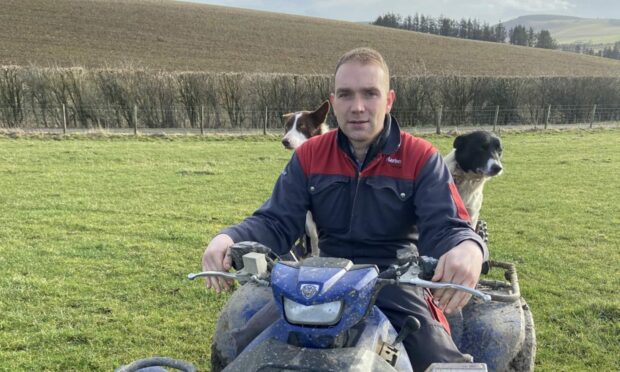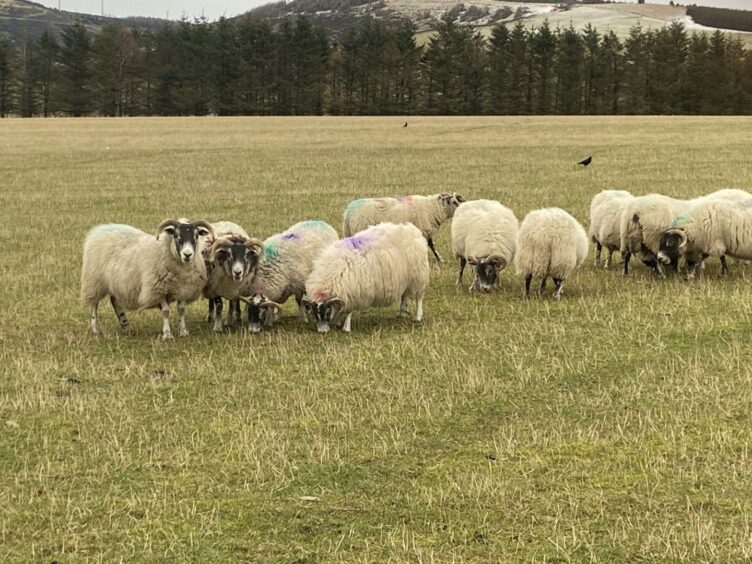Ewe nutrition is key in the Hunter family’s breeding sheep flock at Wedderburn and it’s Harbro’s Clover Premium Ewe 18 which helps achieve the success.
Jim and Alyson Hunter, together with their son Sandy, farm the 400-acre unit in the Glens of Foudland, near Huntly, known as one of Aberdeenshire’s most toughest areas in the winter.
Sandy is the third generation to farm at Wedderburn, after his grandfather Willie, purchased the unit back in the 1940s.
The family runs 1,000 breeding ewes which lamb outside in some of the harshest conditions, with the farm ranging from 800ft to 1,300ft above sea level.
Their flock includes 400 Blackfaces ewes which are bred pure and 300 Blackfaces tupped to the Bluefaced Leicester. Around 200 Scotch Mules are put to the Suffolk, with male lambs finished on the farm and ewe lambs kept as recipients.
The remaining 100 ewes are Bluefaced Leicesters, Texel and recipients for carrying embryos.
“Blackfaces were originally crossed with the Border Leicester to breed Greyfaces, before moving to cross them with Bluefaced Leicesters to breed Scotch Mules,” said Jim.
“Our aim is to be as self-sufficient as possible, breeding all our own Blackfaces and Bluefaced Leicesters. We buy in Suffolk tups and to keep the genetics fresh, new Blackface and Bluefaced Leicester stock tups are bought annually.”
Tups are bought on their merits and what is required on farm.
“In a Blackface tup, we’re looking for a sheep with good structure and a bit of length,” said Sandy.
“For Texels and Bluefaced Leicesters, we’re always looking for something a bit different that’ll bring a little X factor to the flock. Over the years, we’ve noticed that Suffolks with nice, smooth, silky black hair, crossed with the Scotch Mules produce ewes that milk the best and are the best mothers.
“We’ve also found that a sheep with a right tight skin will always be a better sheep, whether for breeding or finishing.”
Home-bred Texel, Bluefaced Leicester and Blackface tups are sold at local and national sales throughout the back end.
The Hunter family has used Clover Premium Ewe 18 for as long as they can remember, with Ian Anderson, providing Harbro support for all the livestock which includes a pedigree Limousin herd.
Ian stresses the importance of quality ewe feed in how it sets up the lamb for its lifetime performance.
“Feeding ewes right ahead of lambing time helps quality and quantity of both colostrum and milk which then influences lamb growth,” said Ian.
“This means we get robust and resilient animals which thrive, grow and finish better.”
Premium ewe rolls are fed to all the sheep at Wedderburn, including recipient ewes.
Jim and Sandy said they find it a good ”all-rounder” and it does well for everything, whether it’s for maintenance or feeding a bit more milk.
Lambing begins inside in mid-February, with pedigrees and embryo recipients, then the Mules in April.
All Blackfaces lamb outside from early April to May.
“We are quite heavily stocked here and rent some grazing but the majority of the breeding ewes are kept in the Glens,” said Sandy.
“We rely heavily on home-grown silage for feeding from December through to lambing, with ewes scanned in the last week of January.
“Feeding begins in February depending on condition and ewes get fed for a solid month after lambing and possibly longer, depending on grass growth.”
For twin and triplet bearing ewes, the Hunters have found that feeding a lesser rate over a longer time works best.
“Once scanned, the ewes are batched and remain batched in the same fields where they receive ewe rolls along with silage, molasses and Energyze Vitality licks,” said Sandy.
“This regime keeps the ewes content and in good condition. It allows our remaining fields to have plenty fresh grass for ewes once they lamb, to keep them going and milking better.”
Blackface ewes carrying singles receive silage and Vitality buckets, and ewe rolls if they are on the lean side.
“We have very few cases of twin lamb disease – I could count them on one hand,” said Sandy.
“We find with feeding premium ewe rolls, the ewes have plenty milk and the lambs have vigour. If the ewes are in milk, it’ll take a lot of bad weather to put them down.”


